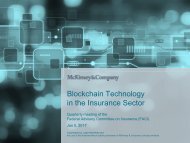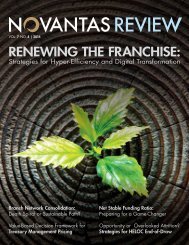The un(der)banked is FinTech’s largest opportunity
DeNovo-Quarterly-Q2-2016.pdf?utm_content=buffer9dd60&utm_medium=social&utm_source=twitter
DeNovo-Quarterly-Q2-2016.pdf?utm_content=buffer9dd60&utm_medium=social&utm_source=twitter
You also want an ePaper? Increase the reach of your titles
YUMPU automatically turns print PDFs into web optimized ePapers that Google loves.
Exhibit 1<br />
Percentage of adults with traditional bank acco<strong>un</strong>ts (by geography)<br />
100 94%<br />
80<br />
69%<br />
60<br />
40<br />
34%<br />
46%<br />
51%<br />
52%<br />
20<br />
0<br />
14%<br />
Middle<br />
East<br />
Sub-Saharan<br />
Africa<br />
South<br />
Asia<br />
Latin America<br />
and<br />
Caribbean<br />
Europe<br />
and<br />
Central Asia<br />
East Asia<br />
and<br />
Pacific<br />
High-income<br />
OECD*<br />
co<strong>un</strong>tries<br />
* Organ<strong>is</strong>ation for<br />
Economic Co-operation<br />
and Development.<br />
Source: Global Findex<br />
database<br />
Many of these basic banking services also help the <strong>un</strong>(<strong>der</strong>)<strong>banked</strong><br />
avoid high fees. Fee reduction or elimination, according to the Fe<strong>der</strong>al<br />
Reserve, <strong>is</strong> the single <strong>largest</strong> benefit of having a formal bank acco<strong>un</strong>t in<br />
markets where alternatives already ex<strong>is</strong>t. In the U.S. market alone, the<br />
<strong>un</strong>(<strong>der</strong>)<strong>banked</strong> spend 2.5% to 5.0% just to access payroll f<strong>un</strong>ds. Further,<br />
with a lack of cards or checks, the <strong>un</strong>(<strong>der</strong>)<strong>banked</strong> incur additional fees<br />
when they use money or<strong>der</strong>s or other noncash payment methods; these<br />
fees often exceed average bank fees.<br />
Mobile <strong>is</strong> the essential enabling technology for financial inclusion.<br />
To begin to reach the <strong>un</strong>(<strong>der</strong>)<strong>banked</strong>, ubiquitous reach or access <strong>is</strong><br />
needed, and mobile has proven to be the answer. Mobile has moved<br />
beyond being a new delivery channel and now provides basic banking<br />
services to <strong>un</strong>(<strong>der</strong>)<strong>banked</strong> populations in remote areas that lack<br />
financial services infrastructure.<br />
<strong>The</strong>re are several examples where mobile-delivered services have<br />
improved financial inclusion. <strong>The</strong> most notable <strong>is</strong> in Kenya, where<br />
regulatory exemptions permitted mobile network operators (MNOs)<br />
such as Safaricom to enter the payment market with an agent-based<br />
banking model. <strong>The</strong>re are now more than 26.2 million mobile money<br />
acco<strong>un</strong>ts in Kenya, 4 roughly equal to the adult population of 26.8<br />
million. 5 However, transitioning to the next step, a formal acco<strong>un</strong>t,<br />
remains elusive in many developing nations (see Exhibit 2, next page).<br />
Mobile has<br />
moved beyond a<br />
delivery channel<br />
to now provide<br />
basic banking<br />
services.<br />
8 Strategy&




